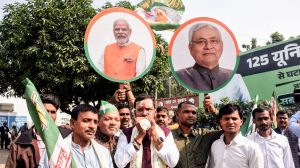A Pacific monster is threatening to gobble Indian monsoon
WASHINGTON, June 25: If Indian planners, economists, bureaucrats and concerned politicians are gloomy this fortnight, there is a good reaso...

WASHINGTON, June 25: If Indian planners, economists, bureaucrats and concerned politicians are gloomy this fortnight, there is a good reason. Winds from the western world have brought bad news, and not just metaphorically. Last week, climatologists in the United States predicted that a severe case of El Nino was in the offing, and in an almost offhand reference, said it could affect the monsoon and cause drought in India, among other places.
El Nino — which translates into English as The child Christ’ because it usually occurs late in the year around Christmas time — is a destructive weather system that meteorologists say presages climatic changes in the southern tier of the United States, northeast Brazil, southeastern Africa, west Pacific and even as far as South Asia and Australia. It is caused by the warming of the Pacific currents.
The news of a possible El Nino and its fallout has rattled Indian planners sufficiently for them to alert domestic meteorologists and also get back to US forecasters seeking more details. Over the weekend, cables were flashing between Delhi and Washington with the same urgency and intensity that becomes a diplomatic crisis. In fact, the tidings could be so ominous that forecasters here who collaborate with Indian meteorologists were asked not to speak to the media — for fear of setting off panic.
The reason is not far too seek. For the last decade, India has had extraordinary good fortune — touch wood — with the monsoon. This factor has helped a great deal in the Indian economy touching seven-per cent growth rate. One bad monsoon and not only will this come unstuck, but there could be vast economic repercussions at a politically fragile time.
Concern in India began after an American forecaster dropped a bombshell last week by predicting an El Nino and making what turns out to be a rather unsubstantiated reference to India. According to Ants Leitmaa, Director of the Climate Prediction Center of the National Oceanic and Atmospheric Administration in Maryland, the world is set to witness one of the biggest El Nino’s in the last 50 years. His reference to India in this context at a Washington briefing was almost casual, but it was picked up by the wire services and attracted notice in India.
Leitma now downplays his comment that El Nino could cause a failure of monsoon, but he insists that one of the biggest El Ninos in decades is currently brewing. “And historically, if you look at it, whenever there has been a big El Nino, India has tended to have less than normal monsoon,” he told The Indian Express.
Not necessarily, say other climatologists. According to Jagdish Shukla, Director of the Center for Ocean Land and Atmospheric Studies (COLA) in Maryland and an acknowledged monsoon expert, the connection between El Nino and monsoons has yet to be clearly established. While there have been drought years with El Nino, there have also been droughts in years with no El Nino, and El Nino years without drought. “What we do know at this time is a big El Nino is developing and we should be wary. I work closely with the Indian government on predicting monsoon and don’t want to hit panic buttons just yet,” Shukla said.
American forecasters also concede just how strong this El Nino will be and what its fallout will be won’t be known fully till August. In fact, the body of knowledge on El Nino itself is only now filling up and this was the first year the phenomenon has been publicly forecast. They have another problem in correlating El Nino and the monsoon. The Indian government is extremely reluctant to share data from its satellites and monsoon records and treats it as classified information.
On their part, Indian planners are suspicious of exaggerated reports about El Nino because of its economic repercussions. It can cause sharp fluctuations in the international grain markets — affecting India’s exports and imports — and could cast a pall over its economic projections and stall investors.
Even now, at the first news of El Nino, rice prices in Chicago’s grain market rose sharply. “There’s legitimate weather concerns. aIf this El Nino does do anything, it will hit rice producing areas in India, the North China plains and the Philippines,” Jack Scottsville, a Chicago analyst, told wire services.
Already, El Nino is agitating some countries. Last week, Peru’s President Albert Fujimori announced a commission with an initial budget of $19 million to minimise the blow. The government plans to focus its preventive work improving agricultural infrastructure, including repairing irrigation channels and strengthening bridges. The Peruvians should know. In 1983, El Nino brought widespread damage. “Even if it is not definitely forming, we must take action beforehand,” says Fujimori.
Suddenly, the weatherman’s word, once the butt of ridicule, is as important as that of a politician. “Perhaps, it is the coming of age of a science,” mused Shukla.


- 01
- 02
- 03
- 04
- 05





























